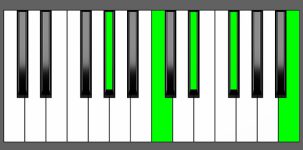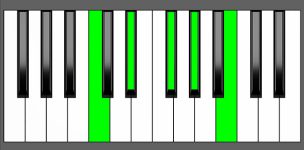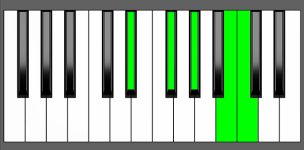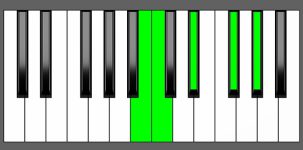Piano Diagram of Ab7#9 in Root Position

An Ab7#9 chord is an altered dominant seventh chord that is built upon the key of Ab. This chord consists of the root Ab, the major third C, the perfect fifth Eb, the minor seventh Gb, and the sharp ninth B. The Ab7#9 chord can be used as a substitute for dominant chords only in specific musical contexts. Keep reading to learn more about the music theory that underpins this chord.
Structure of Ab7#9
Notes |
|---|
| Ab, C, Eb, Gb, B |
Intervals |
|---|
| R, 3, 5, m7, #9 |
How to play an Ab7#9
To play an Ab7#9 chord, you can use the following voicing: start by playing the root note Ab with your left hand. Then, with your right hand, play the notes C (major 3rd), Gb (minor 7th), and B (sharp 9th).
Ab + C, Gb, B
This approach will result in a simplified Ab7#9 chord that includes only the essential notes: the root note, major 3rd, minor 7th, and sharp 9th.
Ab7#9 Chord Inversions
The Ab7#9 chord has a total of 4 inversions:
| Root Position: | Ab | C | Eb | Gb | B |
| 1st Inversion: | C | Eb | Gb | Ab | B |
| 2nd Inversion: | Eb | Gb | Ab | B | C |
| 3rd Inversion: | Gb | Ab | B | C | Eb |
| 4th Inversion: | B | C | Eb | Gb | Ab |
Piano Keyboard Diagrams

Chord Inversions on Piano
Having a solid understanding of chord inversions is a crucial element of music theory since it sheds light on how chords are constructed. When it comes to playing chord inversions on a piano, it’s essential to keep in mind that the charts and graphs depicting the order of notes may not always be feasible or even playable.
To achieve the proper chord voicings on a piano, you must spread the chord notes across various octaves and positions on the keyboard. This often entails deviating from the typical shape of the chord’s inversions shown in charts, which may not be the most practical or comfortable way to play the chord.
While chord inversion charts can help understand the structure and sequence of notes in a chord, it’s always a good idea to experiment with different voicings and fingerings to find the most efficient and comfortable way to play the chord, while still preserving its intended harmonic function and sound.
Music Theory and Harmony of Ab7#9
Dominant 7#9 chords are often referred to as the “Hendrix chord” due to their prominent use in songs like “Voodoo Child“, “Foxy Lady“, and “Purple Haze“. If you know these songs, then you can easily recall the distinct sound and mood of the 7#9 chord.
The Ab7#9 chord can replace or enhance the Ab7 chord, typically on the V degree, but also on the III degree, and occasionally on other degrees as a secondary dominant chord. However, it has a distinct funky vibe, so it should be used carefully in the appropriate musical context.
Before delving into the most frequent usage of this chord, let’s first understand how to construct it.
Building the Ab7#9 Chord: Different Approaches
Starting from the Ab Major Scale:
To form a 7#9 chord, you combine the root, the major 3rd, the 5th, the minor 7th, and the sharp 9th from a major scale.


To create an Ab7#9 chord, apply the formula R, 3, 5, m7, #9 in the following manner:
- Begin with the Root note, which is Ab.
- Select the major 3rd interval, which is C, and add it to the chord.
- Add the 5th interval, which is Eb.
- Add the minor 7th interval, Gb.
- Finally, select the 9th (Bb) and add a half tone to get the #9th, B.
By following this simple formula, you can create a 7#9 chord from any major scale.
by Combining Intervals:
One method to create a 7#9 chord is by combining specific intervals – a major 3rd, a minor 3rd, and a perfect 4th.
3 + m3 + m3 + 4 = 7#9 Chords
For example, to build an Ab7#9 chord:
- we start with the root note Ab.
- We then add a major 3rd interval, which is four half-steps up from the root, to get C.
- Next, we add a minor 3rd interval, which is three half-steps up from C, to get Eb.
- Then, we add another minor 3rd so we find the minor 7th Gb and
- lastly, we add a perfect 4th interval, which is five half-steps up from Gb, to get B.
Together, these intervals form the Ab7#9 chord.
How to Use Ab7#9 in a Chord Progression
The Ab7#9 can work as a substitute or as a passing chord to an Ab7 that can be found in major and natural minor scales. The 7#9 chord is considered a non-diatonic chord, which means that it contains notes that are not found in either the major or minor scales. Its unique sound is achieved by adding a sharp 9th interval (which is equivalent to a minor 3rd at the higher octave) to the dominant 7th chord, creating a dissonant yet interesting tonal color.
Most common uses of Ab7#9
Ab7#9 in Db Major and Db minor
The Ab7#9 chord is commonly used as a dominant chord. In the key of Db major, the Ab7#9 chord can be used as the V7 chord, which leads back to the I chord (Db major).
| Major Scale | I | ii | iii | IV | V | vi | vii |
|---|---|---|---|---|---|---|---|
| Db | Db Maj7 | Eb min7 | F min7 | Gb Maj7 | Ab7 ⇒ Ab7#9 | Bb min7 | Cm7b5 |
- Substitute or Passing Chord to the Dominant chord in Db Major
Ab7#9 as Substitute for Ab min7
The Ab7 chord derived from the harmonic minor scale is commonly used to replace an Ab min7 chord in the key of Db minor. In some cases, the Ab7#9 chord can also be used instead of the Ab7 chord, further enhancing the harmonic tension and leading to the Db min7 chord.
However, since Db minor is a theoretical key, we will refer to its enharmonic equivalent key, C# minor.
| Minor Scale | i | ii | III | iv | v | VI | VII |
|---|---|---|---|---|---|---|---|
| Db = C# | C# min7 | D#m7b5 | E Maj7 | F# min7 | G# min7 ⇒ G#7 ⇒ G#7#9 = Ab7#9 | A Maj7 | B7 |
- Substitute or Passing Chord to the Dominant chord in C# minor as G#7#9
Ab7#9 in a I – III7 Progression
The Ab7#9 chord could be used as a substitution for the III degree in an I – III7 chord progression, which traditionally features an Ab minor chord. This chord progression, represented by the chords Fb Maj7 and Ab7, can accommodate the Ab7#9 chord in place of the expected Ab minor chord.
As before, we are in a theoretical key, so it’s more practical to refer to its enharmonic equivalent key E major.
| Major Scale | I | ii | iii | IV | V | vi | vii |
|---|---|---|---|---|---|---|---|
| Fb = E | E Maj7 | F# min7 | G# min7 ⇒ G#7 ⇒ G#7#9 = Ab7#9 | A Maj7 | B7 | C# min7 | D#m7b5 |
- Substitute or Passing Chord to the Mediant chord in E Major as G#7#9
Ab7#9 in Bb minor
While the Ab7#9 chord can be used in the key of Bb minor, it may not be the most common use of this chord.
| Minor Scale | i | ii | III | iv | v | VI | VII |
|---|---|---|---|---|---|---|---|
| Bb | Bb min7 | Cm7b5 | Db Maj7 | Eb min7 | F min7 | Gb Maj7 | Ab7 ⇒ Ab7#9 |
- Substitute or Passing Chord to the Leading Tone chord in Bb minor (less common)
Ab7#9 as Substitute for a Secondary Dominant 7th Chord
Ab secondary dominant is a type of chord that is not in the main key of a musical piece but is used to create a strong pull towards another chord that is. In Western music, the fifth scale degree has a strong “dominant” function and creates tension that resolves to the first scale degree chord (I). Ab secondary dominant chord is used to create this same dominant function but towards a different chord, leading to a temporary departure from the main key.
For example, in the key of Gb major, the chord of Db7 is the V chord and leads back to the I chord of Gb Maj7. Adding another chord between Gb Maj7 and Db7 that creates a strong pull towards Db7 creates a secondary dominant chord. In this case, using an Ab7 chord creates a pull towards Db7, as Ab7 is the V chord in the key of Db.
| Gb Maj7 | Db7 |
⇒
| Gb Maj7 | Ab7 | Db7 |
Instead of using a regular Ab7 chord, you can also use the Ab7#9 chord in place of or together with it. This substitution or addition can add more tension and complexity to the progression, leading to a more interesting and dynamic musical result.
| Gb Maj7 | Db7 |
⇒
| Gb Maj7 | Ab7/Ab7#9 | Db7 |
Ab7#9 Chord Function in Major and Minor Keys
Ab7#9 as Dominant Chord in Db Major
In the key of Db major, the Ab7 chord would be the dominant chord. The Ab7 chord can be coupled or substituted by an Ab7#9, let’s see how:
| I | ii | iii | IV | V | vi | vii |
| Db Maj7 | Eb min7 | F min7 | Gb Maj7 | Ab7 | Bb min7 | Cm7b5 |
Ab7#9 Chord Progressions as V degree
Try playing these chord progressions to get an idea of how Ab7#9 functions near the dominant chord. I like to use it followed by an Ab7b9 but feel free to experiment.
ii V I
| ii | V | I |
| Eb min7 | Ab7#9 | Ab7b9
Ab (C, Gb, B) | Ab (C, Gb, Bbb) |
Db Maj7 |
I IV vi V
| I | IV | vi | V |
| Db Maj7 | Gb Maj7 | Bb min 7 | Ab7#9 | Ab7b9 |
I IV ii V iii vi ii V
| I | IV | ii | V | iii | vi | ii | V |
| Db Maj7 | Gb Maj7 | Eb min7 | Ab7#9 | Ab7b9 | F min7 | Bb min7 | Eb min7 | Ab7#9 | Ab7b9 |
Ab7#9 as Dominant Chord in Db minor
Ab7#9 as III7 Degree in Fb Major
Ab7#9 as Leading Tone Chord in Bb minor
In the key of Bb minor, the Ab7 chord is built on the leading tone, which is the seventh note of the scale. This chord can be replaced or modulated by an Ab7#9, although it may not be the most ideal position for this chord. Nonetheless, it can still be a valid option in certain musical contexts.
| i | ii | III | iv | v | VI | VII |
| Bb min7 | Cm7b5 | Db Maj7 | Eb min7 | F min7 | Gb Maj7 | Ab7 |
Ab7#9 as VII degree – Chord Progressions
i iv VII i
| i | iv | VII | i |
| Bb min7 | Eb min7 | Ab7#9 | Ab7b9 | Bb min7 |
i iv VII III
| i | iv | VII | III |
| Bb min7 | Eb min7 | Ab7#9 | Ab7b9 | Db Maj7 |
Circle Progression
| i | iv | VII | III | VI | ii | V7 | i |
| Bb min7 | Eb min7 | Ab7#9 | Ab7b9 | Db Maj7 | Gb Maj7 | Cm7b5 | F7 | Bb min7 |
Alternative Ab7#9 Nomenclature
- Ab 7+9
- Ab 7(#9)
- Lab 7#9
- Ab 7#9th
- Ab dom7#9
- Ab Dominant 7th #9
- Ab Dominant Seventh Sharp Ninth
Conclusion
The chord progressions and examples presented in this post provide a comprehensive overview of the most common uses of the Ab7#9 chord. It’s important to note, however, that many advanced harmony-related topics could not be included due to space constraints. These topics include chord progressions built on harmonic and melodic scales, modal scales, hidden tonality, secondary dominants and other chord substitutions, non-functional harmony and atonal music, modal interchange and borrowed chords, voice leading and counterpoint, chromatisms, jazz harmony…I mean, music theory is a huge topic!
Although I couldn’t cover all of these topics in my post, I encourage readers to continue exploring these areas in their own study and research. By expanding your knowledge in these advanced areas of music theory, you can gain a deeper understanding of the harmonic possibilities that exist beyond the basics presented here.




Great job on everything except what I am looking for: the actual notation on a staff of a Ab7(#9) chord. I understand how to play it and I understand what each note is my problem is in writing it in sheet music. If you represent the (#9) as a B and in the key of Ab the B is flat won’t that be played as a Bb? The only way I can see to do it would be to put a natural sign (accidental) in front of the B note. Or a (#) accidental?
Another way of asking the question might be: how do you sharp a flat in notation?
It would help however, to see the notation of a Ab7(#9). Appreciate your work very much it is very well laid out and understandable. Thank you!
Thank you so much for your thoughtful comment and kind words! You’ve raised an excellent and very practical question about notation.
For an Ab7(#9) chord, the chord tones are:
As you correctly noted, in the key of Ab, the 9th would normally be spelled as Bb. When that interval is altered (raised), the proper enharmonic spelling is B natural, not C♭ or Bb♯. To notate this in sheet music, you’d indeed write a B with a natural sign to show the raised 9th. This keeps the function of the chord clear: it’s still the 9th degree, just altered upward.
So the complete notation on a staff would show: Ab – C – Eb – Gb – B♮.
To answer your other question directly: in traditional notation, you don’t “sharp a flat.” Instead, you respell the note so it reflects its function (here, the 9th) and then use the appropriate accidental (natural or sharp).
I hope this clears things up, and I really appreciate your thoughtful engagement with the topic!